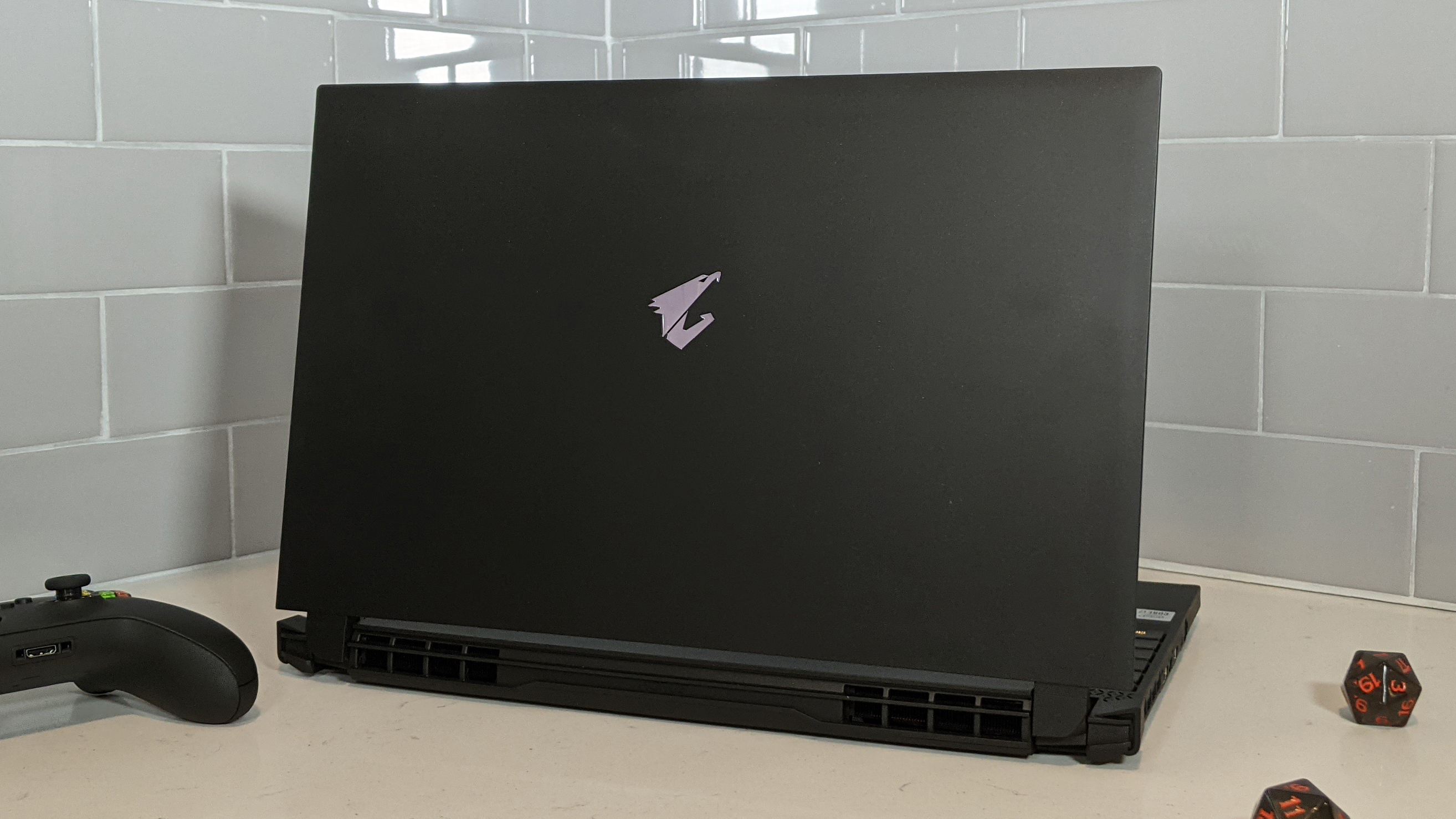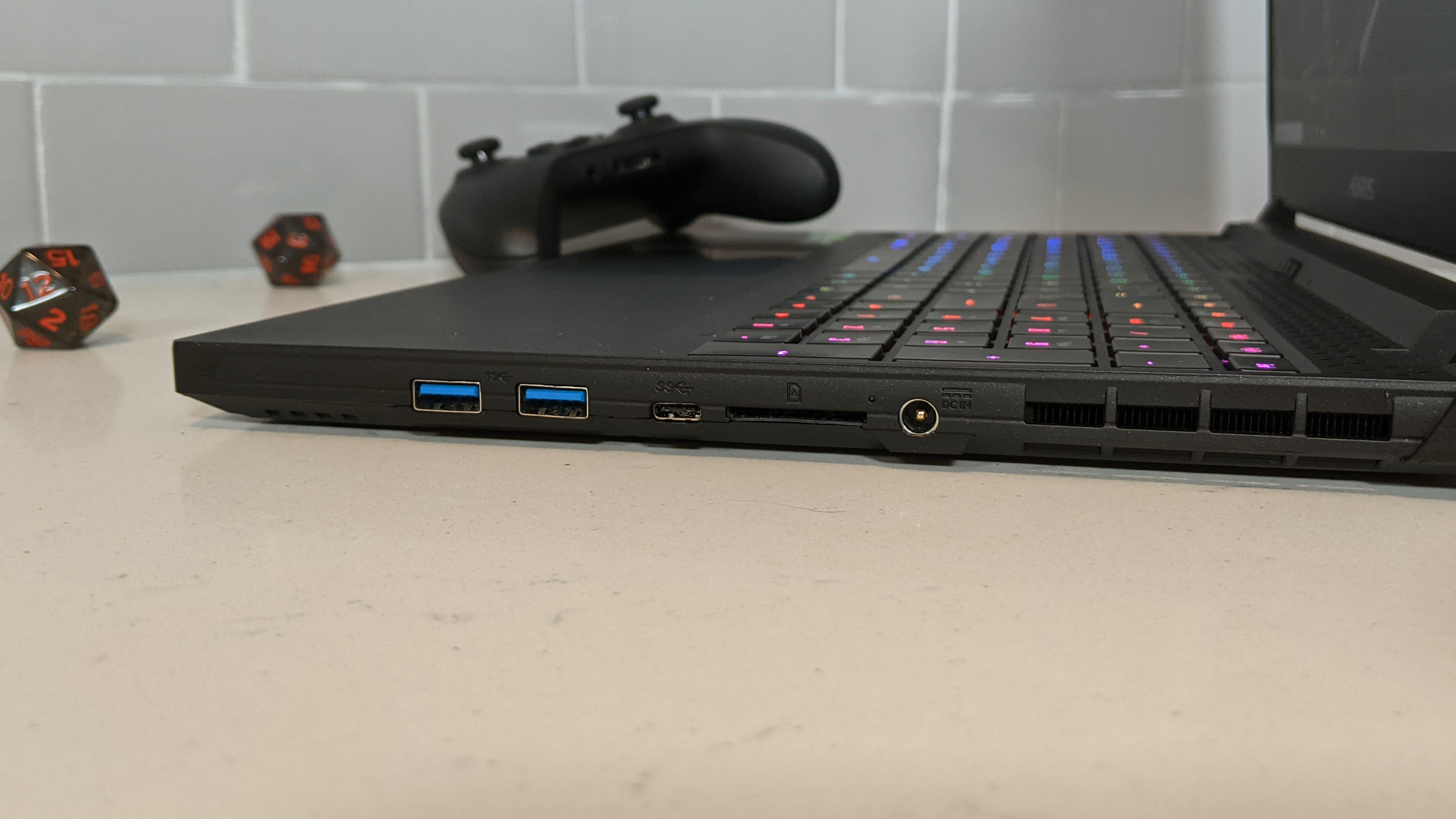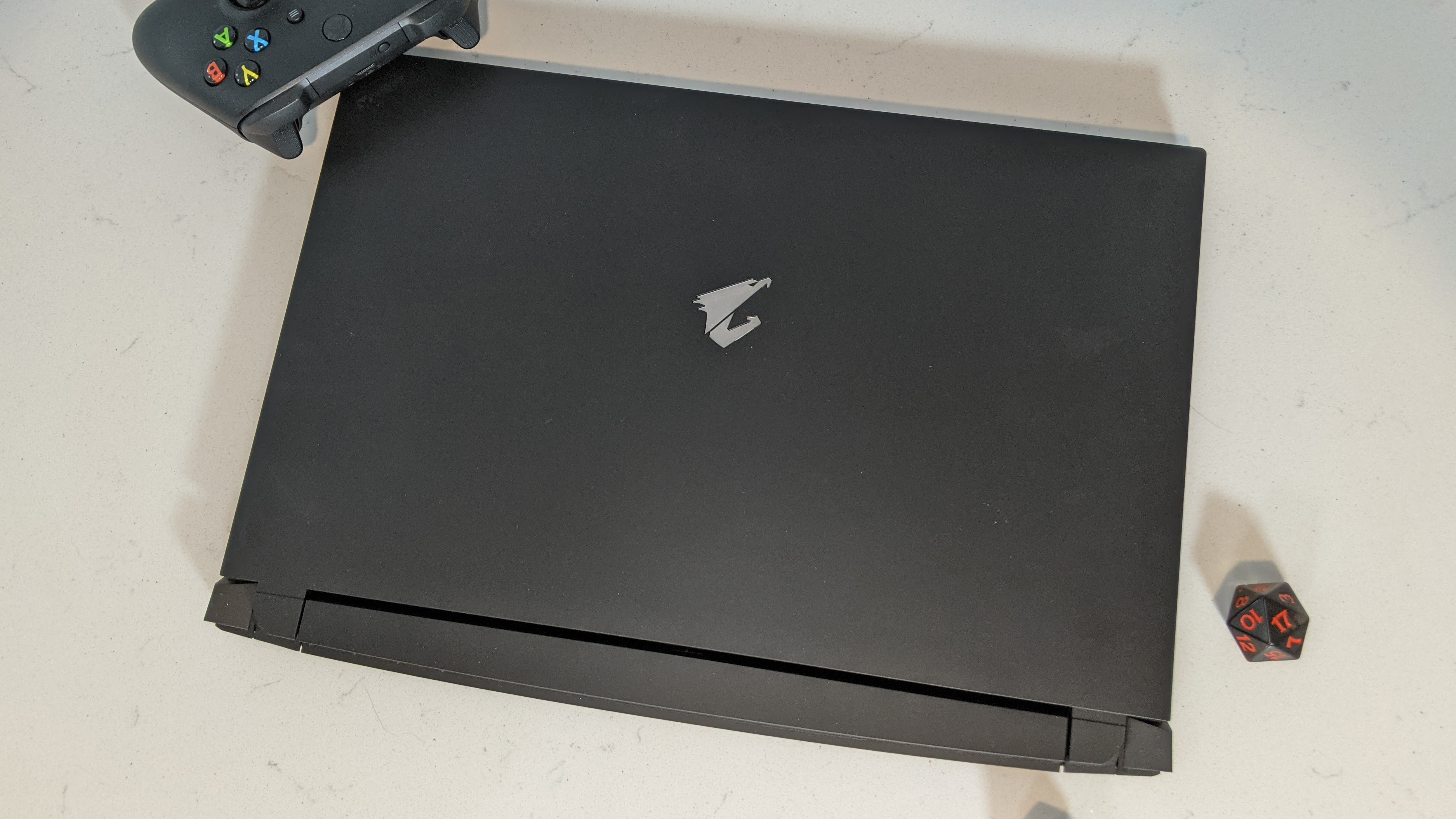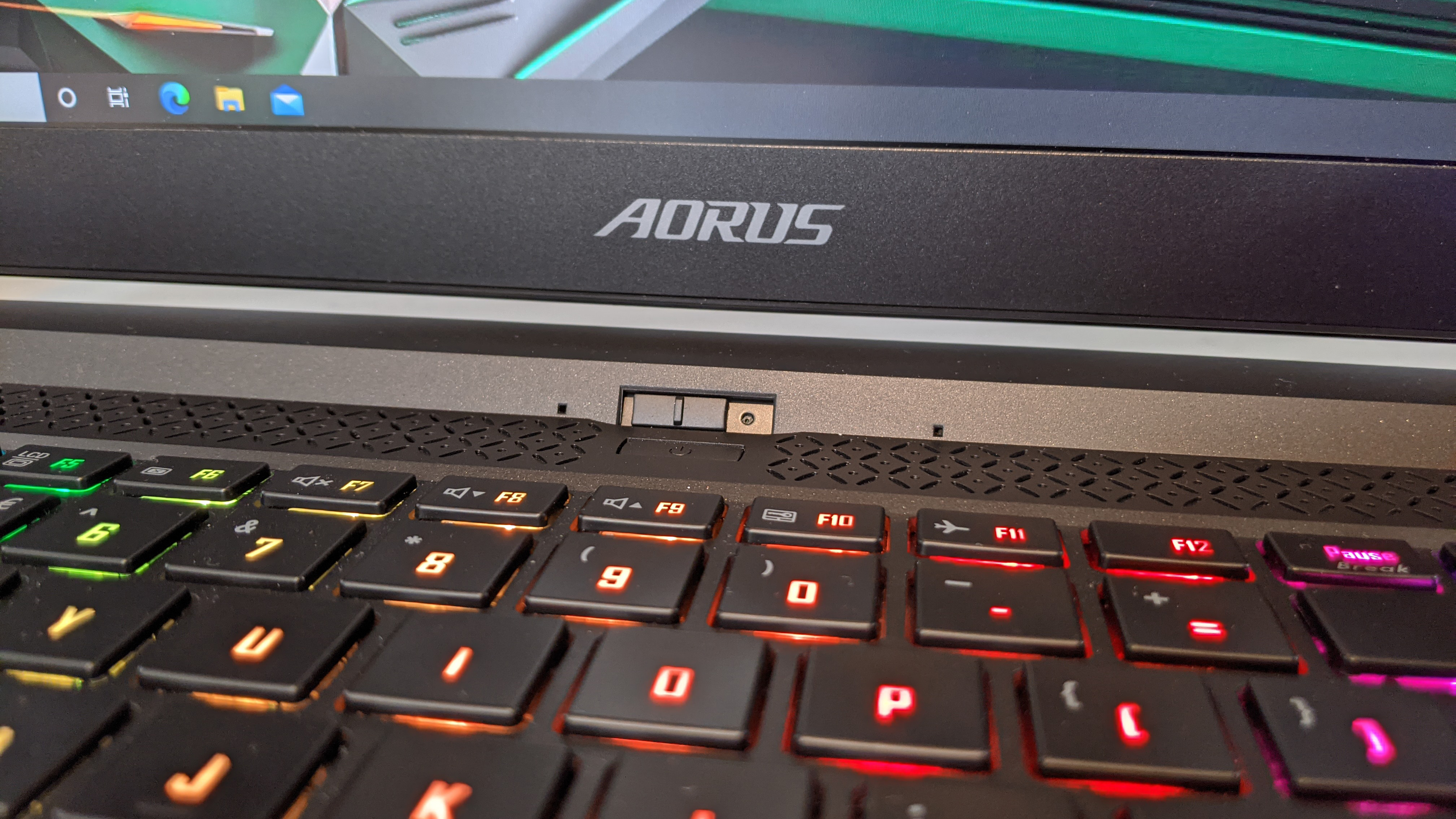Laptop Mag Verdict
The Gigabyte Aorus 15G sports a killer RTX 3070 GPU, but between short battery life, a squishy keyboard and mediocre speakers, the graphics card can’t make up for everything.
Pros
- +
Stellar performance and graphics
- +
Small footprint
- +
Colorful, 240Hz panel
Cons
- -
Short battery life
- -
Display could be brighter
- -
Poorly placed webcam
- -
Squishy keyboard
- -
Mediocre speakers
- -
Runs hot
Why you can trust Laptop Mag
Yes, 2020 was garbage, but 2021 is the year of Nvidia’s RTX 30 series GPUs, so that means gaming laptops are getting a much-needed power-up. Unfortunately, in the case of the Gigabyte Aorus 15G, that extra performance doesn’t make it a good gaming laptop.
For $1,799, the Aorus 15G offers excellent performance from its Intel Core i7-10870H processor and Nvidia GeForce RTX 3070 GPU as well as a colorful, 15.6-inch, 240Hz panel packed into a rather small chassis. However, this machine has one too many issues, including short battery life, a dim display, a poorly placed webcam, a squishy keyboard and a pair of mediocre speakers all shoved into a system that runs a bit too hot.
There’s a lot that you would have to overlook to be OK with the Gigabyte Aorus 15G, and you can definitely find better machines on our best gaming laptops page.
Gigabyte Aorus 15G (2021, RTX 3070) price and configuration options
Price: $1,799
CPU: Intel Core i7-10870H
GPU: Nvidia GeForce RTX 3070
RAM: 32GB
Storage: 512GB SSD
Display: 15.6-inch, 1080p, 240Hz
Battery: 4:48
Size: 14.0 x 9.6 x 0.9 inches
Weight: 4.7 pounds
The Gigabyte Aorus 15G model I reviewed costs $1,799 and is outfitted with an Intel Core i7-10870H processor, a brand new Nvidia GeForce RTX 3070 GPU with 8GB of VRAM, 32GB of RAM, a 512GB SSD and a 15.6-inch 1080p, 240Hz display.
The only other available model gets bumped up with an RTX 3080 GPU and a 1TB SSD all for $1,999. As far as components go, that’s a steal for only $200 extra. But, it’s a bit ridiculous that our model comes with only a 512GB SSD to begin with.
If you’re looking for something that’s not in the quadruple-digit range, check out our best cheap gaming laptops page.
Gigabyte Aorus 15G (2021, RTX 3070) design
Toning down the silver look, the Aorus 15G now sports a sleek black color over its aluminum lid. It’s rather plain apart from the illuminated Aorus logo at the center. However, if you’re looking for a gaming laptop that’s subtle, this might work for you.
Sign up to receive The Snapshot, a free special dispatch from Laptop Mag, in your inbox.

Popping the hood revealed an edge-to-edge per-key RGB-lit keyboard with a decently sized touchpad below it and a long vent above it. The side and top bezels are incredibly thin at the cost of the webcam being placed on the hinge, of all places, but at least it has a privacy shutter! That’s like the equivalent of taking all the cheese off of a pizza and just getting the crust.
At 4.7 pounds and 14.0 x 9.6 x 0.9 inches, the Gigabyte Aorus 15G features a rather small footprint compared to other 15-inch laptops. The Asus ROG Strix Scar 15 (5.7 pounds, 14.2 x 10.8 x 1 inches), MSI GE66 Raider Dragonshield (5.3 pounds, 14.1 x 10.5 x 0.9 inches), Acer Predator Triton 500 (2020) (4.6 pounds, 14.1 x 10.0 x 0.7 inches) and Alienware m15 R4 (5.3 pounds, 14.2 x 10.9 x 0.7~0.8 inches) were just a bit bigger in length and width.
Gigabyte Aorus 15G (2021, RTX 3070) ports
The Gigabyte Aorus 15G features a decent number of ports onboard.

On the left, you’ll find an HDMI port, a Mini DisplayPort, one USB Type-A port, a headphone jack and an RJ45 Ethernet port, while the right side holds room for the power jack, an SD card slot, one USB Type-C port and two USB Type-A ports.

If you happen to need more ports, check out our best laptop docking stations and best USB Type-C hubs pages.
Gigabyte Aorus 15G (2021, RTX 3070) display
The Aorus 15G’s 15.6-inch, 1920 x 1080-pixel display is a little on the dim side, but it is plenty colorful and features a smooth 240Hz refresh rate.

In the Cherry trailer, Tom Holland’s blue jacket popped against the yellowish dream-like background. When the couple sat together under a staircase in the dark, it was difficult to suss out the detail in the wall behind them because the display was dim at max brightness. However, the strands of hair on Holland’s wig were sharp (I’m assuming it’s a wig, I just saw three different hairstyles in the past 3 minutes).
In Assassin’s Creed Valhalla, I planted my ax in some dude’s neck and the blood that sprayed had a bold glow to it, contrasting well to the lush greenery it landed on. However, when I made my way through a fort, I ended up in a dimly-lit room, and it was difficult to make out what was in the corner despite the screen brightness being maxed out. When I turned down my settings to low, I got to experience the super-fast refresh rate as I dashed across a field and shot an arrow at the first enemy I saw (jokes on me though, it was a Zealot).
According to our colorimeter, the Aorus 15G covered 76.7% of the DCI-P3 color gamut, which surpassed the average mainstream gaming laptop (68.2%). It landed somewhere between the Strix Scar G15 (80%), Raider Dragonshield (75.7%) and Predator Triton 500 (77.4%). However, the Alienware m15 soared with 149.5%.
At a peak of 259 nits, the Aorus 15G is pretty dim, falling short of the category average (283 nits). It couldn’t even keep up with the Strix Scar G15 (278 nits), Raider Dragonshield (310 nits), Predator Triton 500 (322 nits) or Alienware m15 (362 nits).
Gigabyte Aorus 15G (2021, RTX 3070) keyboard and touchpad
While the keyboard deck is comfortable enough for my palms, the Aorus 15G doesn’t offer a great typing experience, as the keys felt too soft against my fingers.

I hit 77 words per minute on the 10fastfingers.com typing test, which is around my current 78-wpm average. The keyboard is something you could get used to, but it’s way too squishy for a gaming laptop.
Despite that, the RGB-lighting is super vibrant and easy to configure. In the Aorus Control Center, you simply go over to the Fusion tab and choose between a number of presets like Wave or Raindrop. You can also create your own custom preset.
The 4.1 x 2.8-inch touchpad is pleasantly soft, although the clickers are a bit on the stiff side. However, Windows 10 gestures like two-finger scrolling and three-finger tabbing worked well.
Gigabyte Aorus 15G (2021, RTX 3070) audio
The previous Aorus 15G didn’t have good speakers, and this one doesn't either, unfortunately. Its two bottom-firing speakers lack bass and produce shallow sounds.
I listened to Burn The Ballroom’s “Whisper,” and while the opening vocals were designed to sound shallow, they were even more so due to the lack of well-rounded bass. The drums sounded oddly sharp, and the electric guitar was too noisy and unrefined. The vocals were clear, but all of the instruments playing together sounded muddy.
I raided a monastery in Assassin’s Creed Valhalla, and the sound of the tolling church bells was hollow, but still loud enough to overshadow what was happening. What sounded really gross was shooting my arrow in some dude’s shield and getting a weird squishy sound instead of a satisfying thud. Even cutting through my enemies with an ax sounded like I was hearing a fight happening outside of my house instead of directly in front of me.
The Nahimic audio app didn’t help much, but it has a great number of settings that you can manipulate. There are four presets: Music, Movie, Communication and Gaming. Within each preset are settings for surround sound, volume stabilization, voices, bass and treble. There’s even a customizable equalizer.
Nvidia’s 30-series era begins
The Gigabyte Aorus 15G is the first gaming laptop that I've gotten my hands on with an Nvidia GeForce RTX 3070 GPU. The chip and its 8GB of video memory are bringing faster performances and twice the efficiency. The new 30-series chip uses Nvidia’s 2nd-generation RTX Ampere architecture, which is the company’s first 8nm chip. Despite the smaller size, Nvidia still managed to fit even more transistors on the chipset. How many more? Billions! More transistors means more power, which is rarely a bad thing.
Made using a custom system, for all intents and purposes, Ampere chips are three processors in one. You’ve got the Shader, which handles 3D shading (lighting, darkness, color levels) in a rendered image as well as other post-processing functionality. There are 2nd-generation RT Cores that handle that all-important ray-tracing technology and a 3rd-generation Tensor Core, which powers artificial intelligence calculations.
But what’s the use of all that power without some kick-ass functionality? With the Ampere chips, 30-series laptops will bring a host of gamer-centric features including the 3rd-generation of Max-Q design, which brings with it Dynamic Boost 2.0 and WhisperMode 2.0. Powered by AI, Dynamic Boost 2.0 intelligently sends power between the processor, GPU and VRAM as necessary for that efficiency that I mentioned earlier. The improved WhisperMode also works with the CPU and GPU as well as the laptop’s fans. By monitoring system temperature, WhisperMode provides the optimal acoustics so you don’t have to worry about blaring fan noise.
Another AI-powered feature is DLSS or Deep Learning Super Sampling. DLSS allows a gaming laptop, which has more pronounced power restraints, to achieve double the performance without exceeding thermal or power limits. It helps deliver those high frame rates you’ve come to expect from a high-end Nvidia system.
Nvidia’s Optimus technology has also gotten an upgrade. For the uninitiated, Optimus automatically switches between integrated and discrete graphics to preserve battery life. Less taxing programs use integrated GPUs while games, photo and video-editing software will tap into discrete GPUs. This latest iteration of the feature, called Advanced Optimus, uses a hardware switch that controls which GPU is connected to the display at any given time.
Unlike previous versions, Advanced Optimus plays nice with Nvidia’s G-Sync technology. G-Sync matches up the display’s refresh rate with the GPU for a smoother, faster gaming experience. With Advanced Optimus, gamers get the benefit of longer battery life and displays pushing out higher refresh rates (1440p displays at 240Hz and 4K at 120Hz). The feature can be toggled between Automatic, Optimus and Nvidia GPU-only in the Nvidia Control Panel.
Another performance enhancement comes by way of the Resizable Bar. Instead of the video memory having to process smaller processing requests at a time, the Resizable Bar allows the CPU to access the framebuffer capability in one big batch, which is better for performance.
Other Nvidia goodies are Reflex, which uses G-Sync tech to cut down on latency, an incredibly important benefit for eSports games. Broadcast allows you to turn a meager gaming nook into a passable streaming headquarters by way of AI functionality, which cancels out ambient noise, automatic webcam framing and the ability to create virtual background effects.
Gigabyte Aorus 15G (2021, RTX 3070) gaming, graphics and VR
Tucked away in the belly of the beast lies an Nvidia GeForce RTX 3070 Max-Q GPU with 8GB of VRAM, a brand new graphics card from Nvidia. So, how much more powerful are these chips? Well, to give you an idea, I parkoured my way up a mountain and assassinated two foes at once in Assassin’s Creed Valhalla on Ultra, 1080p settings, averaging a smooth 63 frames per second.

On the Assassin’s Creed Odyssey benchmark (Ultra, 1080p), the Aorus 15G hit 62 fps, soaring past the 47-fps mainstream gaming laptop average. The Aorus 15G’s RTX 3070 beat the Strix Scar G15’s RTX 2070 Super (60 fps), but it met resistance from the Raider Dragonshield’s RTX 2070 Super (63 fps), the Predator Triton 500’s RTX 2080 Super (64 fps) and the Alienware m15’s RTX 3070 (67 fps).
The Aorus 15G nailed 70 fps on the Borderlands 3 benchmark (Badass, 1080p), which flew past the 51 fps category average. It even managed to topple the performance from the Strix Scar G15 (65 fps), Raider Dragonshield (66 fps) and Predator Triton 500 (68 fps). However, the Alienware m15 scored 85 fps.
While the Aorus 15G managed 93 fps on the Far Cry New Dawn benchmark (Ultra, 1080p), beating the average mainstream gaming laptop (75 fps), the Strix Scar G15 (90 fps) and the Alienware m15 (91 fps), it fell behind the Raider Dragonshield (95 fps) and Predator Triton 500 (95 fps).
On the Red Dead Redemption 2 benchmark (Medium, 1080p), the Aorus 15G averaged 59 fps, beating the 42-fps category average. It landed between the Strix Scar G15 (60 fps), Raider Dragonshield (58 fps) and Predator Triton 500 (61 fps) in a tight race. However, the Alienware m15 excelled with 69 fps.
Gigabyte Aorus 15G (2021, RTX 3070) performance
Paired with the new GPU is an Intel Core i7-10870H processor with 32GB of RAM. It’s more than powerful enough to shrug off 40 Google Chrome tabs and five 1080p YouTube videos while Assassin’s Creed Valhalla ran in the background.
On the Geekbench 5.2 overall performance test, the Aorus 15G scored 8,009, crushing the mainstream gaming laptop average (5,025). It also surpassed the Predator Triton 500’s Core i7-10875H CPU (7,666) and the Alienware m15’s Core i7-10870H (7,636), but couldn’t match up against the Core i9-10980HK CPU in the Strix Scar G15 (8,163) and Raider Dragonshield (8,571).
The Aorus 15G transcoded a 4K video to 1080p in just 8 minutes and 5 seconds on our HandBrake benchmark, which is faster than the 8:27 category average. However, it couldn’t beat the Strix Scar G15 (7:26), Raider Dragonshield (7:01), Predator Triton 500 (7:37) or Alienware m15 (7:07).
Gigabyte’s 512GB SSD has a transfer rate of 801 MBps, which is faster than the average mainstream gaming laptop (675 MBps). However, the SSDs in the Strix Scar G15 (1,542 MBps), Raider Dragonshield (993 MBps), Predator Triton 500 (1,403 MBps) and Alienware m15 (1055 MBps) were much faster.
Gigabyte Aorus 15G (2021, RTX 3070) battery life
Gaming laptops have been up and down when it comes to battery life recently, and there’s definitely more pressure on companies to keep it up. Unfortunately, the Aorus 15G falters in this regard.
The Aorus 15G survived only 4 hours and 48 minutes on the Laptop Mag battery test, which is several hours behind the average mainstream gaming laptop average mainstream (7:22). However, the Strix Scar G15 (4:38), Raider Dragonshield (5:10), Predator Triton 500 (3:46) and Alienware m15 (4:01) didn’t come close to the average, either. Still, that doesn’t excuse poor performance.
Gigabyte Aorus 15G (2021, RTX 3070) webcam
If I see another laptop in 2021 with a bottom-oriented webcam, I’m going to explode. Why does anyone think this is a good idea?

You know what this 720p shooter caught on camera? My fingers typing and my big nose. This thing isn’t even technically located on the bottom bezel. It’s actually on the deck, so it can’t even move. It does, at least, have a privacy shutter, because we wouldn’t want the blurry, horribly oriented camera to spy on you. Ironically, the lens does capture color well enough to represent my vivid Legend of Zelda calendar behind me. However, as someone who plays D&D Online, this webcam irks me. Do yourself a favor and check out our best webcams page for something more desirable.
Gigabyte Aorus 15G (2021, RTX 3070) heat
Wow, does this machine get hot. After playing a game for 15 minutes, the Aorus 15G’s underside climbed up to 122 degrees Fahrenheit, which is above our 95-degree comfort threshold. The center of the keyboard and touchpad hit 92 degrees and 75 degrees, respectively. However, the hottest it got was a whopping 154 degrees on the right-center underside.
However, when you’re not gaming, the Aorus 15G will remain relatively cool. After streaming a 15-minute, 1080p video, the underside reached 95 degrees, the keyboard hit 80 degrees, and the touchpad remained at 72 degrees.
Gigabyte Aorus 15G (2021, RTX 3070) software and warranty
As per usual, with the Aorus 15G, you’ll get the Aorus Control Center, which lets you control and monitor the status of your CPU, GPU and fans. Through this app, you can also customize display colors, battery performance and keyboard lighting. There are also settings to make a system backup as well.
There’s Windows 10 bloatware included with the system as well, such as Cooking Fever, Hidden City and Fishdom.
The Aorus 15G comes with a one-year limited warranty.
Bottom line
Yes, the Gigabyte Aorus 15G is powerful thanks to its brand-spankin’ new GPU, and the fact that it’s super portable and has a colorful 240Hz panel is appealing. However, a super-powerful GPU alone does not make a gaming laptop good. This machine falls short on battery life, as well as its display, webcam, keyboard, speakers and even its heating solution.
Do yourself a favor and spend a little extra to check out the Alienware m15 R4 ($2,499), which has a much nicer display, a webcam in the right spot, and it doesn’t get nearly as hot.
If you want to get powerful performance for a decent price, the Aorus 15G is here for you, but you have to be okay with its setbacks, of which there are many.

Rami Tabari is the Reviews Editor for Laptop Mag. He reviews every shape and form of a laptop as well as all sorts of cool tech. You can find him sitting at his desk surrounded by a hoarder's dream of laptops, and when he navigates his way out to civilization, you can catch him watching really bad anime or playing some kind of painfully difficult game. He’s the best at every game and he just doesn’t lose. That’s why you’ll occasionally catch his byline attached to the latest Souls-like challenge.

